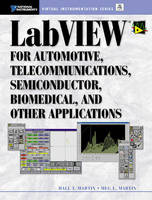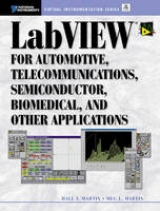LabVIEW for Automotive, Telecommunications, Semiconductor, Biomedical and Other Applications
- Titel ist leider vergriffen;
keine Neuauflage - Artikel merken
The purpose of this book will be to share solutions and examples in test and measurement applications across a broad range of vertical markets. The mainline vertical markets in test and measurement discussed are Telecommunications, Automotive, Semiconductor, Sound & Vibration, General Test & Measurement, and Automation. The book will consist of contributions from leading LabVIEW implementors from all over the world...With an emphasis on how-to, each contribution will focus on practical applications and problem solving, with little or no theory. The breadth of the applications will position the book as an encyclopedia of test and measurement solutions.
1. Automotive Test.
Introduction. Why is Automotive Important? What are the Present Trends and Challenges? What are the Future Trends and Challenges? How does National Instruments Fit In? Electric Vehicle Inverter Durability Test Stand. Introduction. System Description. Results. Machine Vision in Automotive Instrument Manufacturing. Introduction. Objective. System Description. Calibration Utility. Cluster Inspection Utility. Results. Tire Rolling Resistance Measurements Using LabVIEW and VXI. Introduction. Software. Hardware. Results. PC-Based Control of a Gasoline-Fueled Burner Aging Test Stand to Simulate Engine Exhaust. Introduction. System Design. Results. In-Vehicle Data Acquisition, Transfer, and Real-Time Processing. Introduction. Data Acquisition. Test Execution and Data Acquisition Synchronization. Real-Time Analysis. Review Test Data Utility. Results. Automotive Audio Test System. Introduction. Hardware Design Considerations. Hardware Design. Software Design Considerations. Software Design - Administration Utility. Software Design - Client Executable Application. Design Challenges. Results. Ever Take a Picture of a Pothole From a Moving Truck? Introduction. Hardware Design. Software Design. Results. Automated Radio Tester. Introduction. Tests. Test Parameters. Test Results. Test Scheduling. Results.
2. Biomedical Test.
Introduction. Why is Biomedical Important? What are the Present Trends and Challenges? What are the Future Trends and Challenges? How does National Instruments Fit In? Cutting Latency on Assessing Heart Period Variability Studies. Introduction. System Hardware. System Software. Benchmark Measurements. Results. A Cardiovascular Pressure-Dimension Analysis System. Introduction. The System. Data Acquisition and Analysis. Clinical Significance. LabVIEW Tips and Techniques. Conclusion. PC-Based Vision System for Wound Healing Assessment. Introduction. System Hardware and Software. Results. Biomedical Patient Monitoring, Data Acquisition, and Playback with LabVIEW. Introduction. Design Challenge and Solution. Application. Results.
3. Semiconductor Test.
Introduction. Why is Semiconductor Test Important? What are the Present Trends? What are the Future Trends and Challenges? How Does National Instruments Fit In? Angular Scanning Ellipsometer (ASELL). Introduction and System Requirements. System Design. Results. Graphical Modeling of Quantum Atomic State Transitions in Hydrogenic Atoms. Introduction. Wave Functions Under an Applied Field. Separation of Variables in Wave Functions. Graphical Representation of State Transitions. LabVIEW Implementation. Some of the Plots Produced by LabVIEW. Results. Intelligent Automation of Electron Beam Physical Vapor Deposition. Introduction. Monitoring and Analysis. Results. Control System for X-Ray Photolithography Tool. Introduction. Control System. User Interface. Conclusion. Data Acquisition From a Vacuummeter Controlled by RS-232 Standard Using LabVIEW. Introduction. Front Panel Description. Block Diagram Description. Results.
4. Telecommunications Test.
Introduction. What is Telecommunications? What are the Present Trends and Challenges? What is in the Future? How is National Instruments Involved? LabVIEW-Based Antenna Measurements. Introduction. Multipath Distortion. Hardware Control Software. Results. Telecommunications Protocol Analysis Tool. Introduction. System Description. Results. Remote Diagnostics in a Fiber Optic Network. Introduction. Program Design. Results. Quick Real-Time Test of Communication Algorithm Using LabVIEW. System Hardware Control. Benchmark of System Costs. System Cost Reduction. Development Time Reduction. Results. Common Test Software for Cellular Base Stations. Introduction. Requirements. Software Model. Estimated Return on Investment. Results.
5. General Test.
Introduction. Why is General Test Important? What are the Present Trends and Challenges? What are the Future Trends and Challenges? How does National Instruments Fit In? LabVIEW-Based Interactive Teaching Laboratory. Introduction. System Architecture. Sample User Interfaces. Remote Area Experiments over the Internet. Results. PC-Based Data Acquisition System for Measurement and Control of an Isotopic Exchange Installation. Introduction. Product Development Performances. Results. LabVIEW Tests M1A1 Ammunition. Introduction. Testing Procedure. Industrial X-Ray Digital Image Flaw Detection System. Introduction. System Hardware. System Software. System Function and Performance. Results. Large Area Conditioning Systems for the National Ignition Facility. Introduction. Development. Beam Profiler. Analog Data Acquisition. User Interface and Execution Systems. Results. Controlling Aeronautical Hydraulic Actuator Testing with LabVIEW. Introduction. Custom SCXI Module. System Layout. Benefits. Results. Automating the San Francisco Bay Model with LabVIEW. Introduction. System Upgrade. Automation Requirements. System Configuration. Results. Virtual Balancing Equipment for Rigid Rotors. Introduction. System Hardware Configuration. Virtual Balancer Options. Two-Plane, Two Accelerometers Balancer. Innovative Features. Auxiliary Windows. Advantages of the Equipment. Results. LabVIEW-Based Automation of a Direct-Write Laser Beam Micromachining System. Introduction. The Micromachining Application: Process Automation. System Requirements. Database Concepts: Expanding the Materials Space. Results. Future Improvements. Conclusions. Acknowledgements.
Index.
| Erscheint lt. Verlag | 2.6.2000 |
|---|---|
| Verlagsort | Upper Saddle River |
| Sprache | englisch |
| Maße | 180 x 235 mm |
| Gewicht | 527 g |
| Themenwelt | Informatik ► Office Programme ► Outlook |
| Technik ► Maschinenbau | |
| ISBN-10 | 0-13-019963-X / 013019963X |
| ISBN-13 | 978-0-13-019963-8 / 9780130199638 |
| Zustand | Neuware |
| Informationen gemäß Produktsicherheitsverordnung (GPSR) | |
| Haben Sie eine Frage zum Produkt? |
aus dem Bereich




